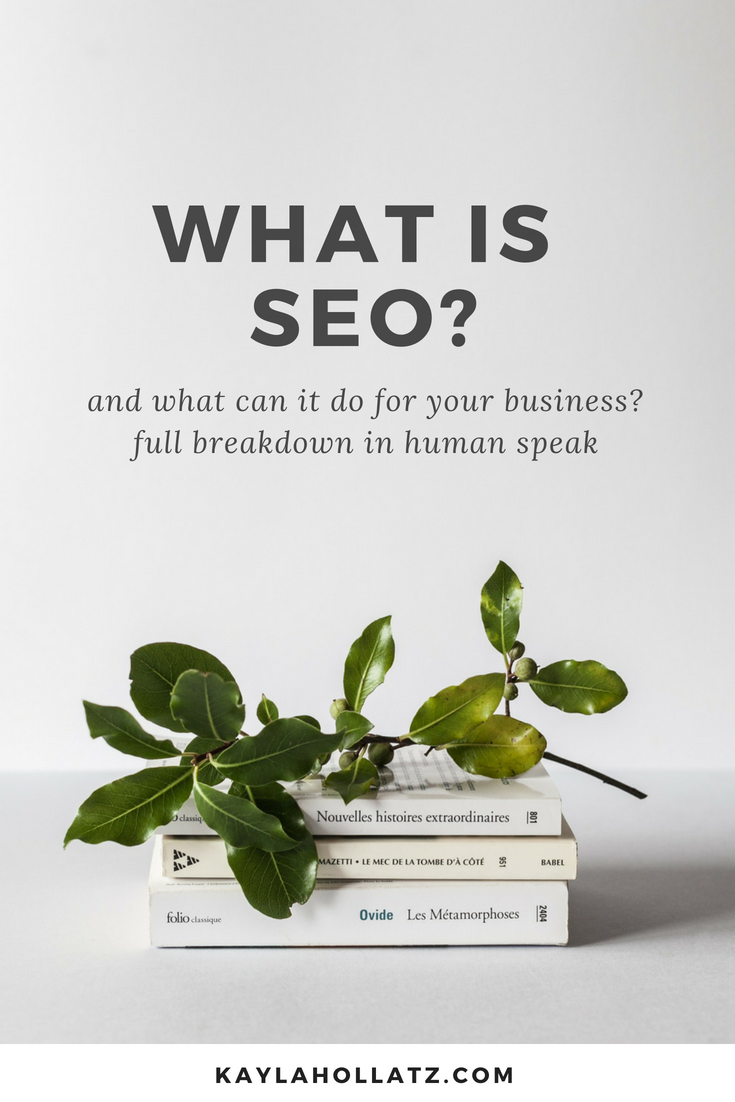What is SEO, and Why Should I Care as a Small Business?
May 30, 2018
When I first started blogging, I didn’t take SEO all that seriously.
I hardly even knew what it was!
My website was more of a passion project than it was a business at that point. When I decided to leave my full-time job three years ago, I had to approach my website differently.
Instead of just writing as a creative outlet, I became more serious about my own website copywriting. I had done some copywriting work for Fortune 500 companies at a PR firm for a while, but this was a whole other beast.
When I transitioned into offering only website copywriting and content creation services, I decided to redesign my website and rethink my own keyword strategy.
Just shy of two years later, I cleared my browser cache and searched for my top four keywords. To my surprise and delight, I was the top result on Google for ALL FOUR of them. No wonder I was getting most of my client inquiries from Google.
All of this is to say that SEO has revolutionized my business (and no, I’m not just saying that because I’m a website copywriter). I know it can do the same for yours.
Let’s talk about why SEO matters for your business too.
Why your website needs to be optimized for search engines
The great thing about optimizing your website for organic search engine traffic (which refers to traffic you don’t have to pay for – score!) is that people often go to Google when they are making a purchasing decision, or at least are considering to make one.
Visitors who turn to Google for answers have a higher probability of converting because they are already actively searching for a solution, so you have an opportunity to provide them with one.
You’ve probably focused more of your time as a small business owner crafting the solution you want to offer rather than optimizing your website to better display and provide that solution.
Don’t worry, that’s why I’m here!
As a creative entrepreneur myself, I’ll break down this seemingly confusing topic in terms we can all understand. While knowing the jargon of SEO can be helpful, it’s better that we put it into language that helps us take action on what we’re learning.
What is SEO?
You’ve probably heard this term a dozen times before, but what does it actually mean? SEO, which is short for search engine optimization, simply means improving your website in order to increase its visibility in search engines.
Let’s use a real-world example. When you type in a keyword or phrase into a search bar, you expect to be provided with a list of the top resources on your topic of choice.
Have you ever wondered how Google decides who gets the top spot? It’s all through SEO!
You’ll often hear people talk about SEO when they say their goal is to get to the #1 spot on Google. This is the most coveted spot in all the land so it should be a goal for all of us.
As you climb toward the top of the SERP (which stands for search engine results page), you increase not only your website traffic but also your credibility. Google is very committed to giving its users the best suggestions and recommendations which is why they take website optimization so seriously.
Anything Google cares about, we should care about!
This is also a good time to say that while Google is not the only search engine out there (I’m looking at you, Bing, Yahoo, and Ask Jeeves… which is somehow still around), it’s the one I’ll be using throughout this series. The other search engines work similarly so rather than constantly say search engines, let’s keep it simple with Google.
Okay, back to the good stuff. Now that you know what SEO is and why you should care about it, let’s talk about the kinds of things Google is looking for. It’s the best way to make sure Google hooks you up with the right visitors.
What search engines like Google are looking for
Before we dig in, remember that Google exists solely to create a great user experience for the people who use the tool. The better their experience is, the more likely they will be to come back and use Google.
This is important because Google depends on traffic to their search engine for advertising. Seeing as they are the number one most visited website on the internet, I’d say they are doing a pretty great job at providing a good user experience. #understatement
Since we are focusing on what search engines like, let’s talk about a few key factors you will want to include in your own search engine optimization strategy.
Relevant evergreen website content
Jargon alert! This definition is thankfully really simple to grasp. Evergreen content is content that stays relevant no matter what time it is consumed. It’s not time-based, like an event recap blog post or a special limited-time offer, so you don’t have to worry about your content going out of style in a few months.
Your website should be built on the foundation of evergreen content. Now, that doesn’t mean you can’t create short-term website pages (which are often called landing pages) with specific timing in mind, but you won’t be focusing on building SEO value with those. Why is that?
SEO is all about improving your website’s performance for the long term. This is why we want to focus on creating evergreen website content that is strong all on its own. We can do this in a few ways, namely by introducing keywords which we’ll talk about next.
Sprinkling keywords into your content
We’ve talked about the beauty of reaching the first page of Google results, but how do you know if you’re doing this whole SEO thing right? It starts with keyword research. Without the right keywords, you’ll be spending time on optimizing for the wrong things.
I have a much more in-depth blog post on keyword research in this blog series, but I’ll give you a little teaser for now. When we think about keywords, let’s assume that you’ve chosen an industry you want to work in and people you want to work with.
Once you have done your own keyword research, which sounds a lot more difficult than it actually is, you can start to weave those keywords into your website copy. Here are a few good places to weave them in:
- Title tags: Before you click into a website from a Google SERP (stands for search engine results page), you’ll often see the website page title tag first. This is because it is the largest text shown on the SERP and is usually colored in blue (unless you’ve clicked on it already so it’s purple).
- Meta description: Underneath your title tag in the SERP, you’ll see a small summary of text describing what the visitor will find on your page. This is what we call a meta description. Place relevant keywords into your meta description, but make sure to weave them in so you don’t get close to keyword stuffing territory.
- Headers: In your website building platform, you’ve probably seen the Heading 1, Heading 2, and Heading 3 options. These features aren’t there just to make your website look pretty. Headers are also a great place to squeeze in some extra SEO value with your keywords. Make sure you have one in there, as long as it is readable and easily digestible.
- Body copy: This refers to all of the content you create in the body paragraphs of your website and blog posts. Instead of listing them all in a row, try spreading them out throughout your content. It may take a little time to get used to it but you’ll start including them in your content instinctively in no time.
Good user experience
There’s that “user experience” term again. It just keeps popping up everywhere! The more you dig into SEO, the more you’ll hear about this term so it’s a good one to understand early on.
User experience refers to, you guessed it, the overall quality of a visitor’s experience on your website. To make a lasting impression, you’ll want to create a good user experience from the get-go.
Here are a few factors that go into a good user experience:
- A well-organized website navigation and overall website structure.
- ONE clear call-to-action (like subscribing to your email list, buying a product, signing up for a consultation call, etc.) on every website page.
- Easy-to-read text formatting with headers, styles, etc. (because no one wants to read a wall of text… not even Google bots)
- Big, bold images to break up your text and add more visual appeal to your content.
- Making sure you don’t frustrate your audience while they are scrolling through your website (like making all of your internal page links open up in a new window… that drives people nuts).
A good user experience doesn’t stop there but this list gives you a good starting point. If you’re still unsure of where to begin, think about the kinds of things you like on other websites you regularly visit. Chances are those things are also appealing to your audience.
If you want your blog to be focused on your quality content, keep the design minimal with no sidebar. If pop-ups turn off your subscribers more than they convert, don’t have them on your homepage.
It’s worth it to continually improve your user experience, so your website traffic and conversion will keep climbing, thanks in large part to Google when you do it right.
Understand how SEO can improve your website traffic
Naturally, there are more than three things that search engines like but this gives you a good foundation. If you are still interested in learning more about SEO, more power to you! This will be an incredibly influential area of your business marketing because the tweaks you make today could provide you with lifetime value.
SEO is all about the long-term strategy so don’t worry about getting it all done in one day or even one month. Any website copywriter and SEO strategist will tell you that it takes time to optimize your website.
With that in mind, here is the next thing you can learn about SEO: Keyword Research Tips from a Website Content Writer




